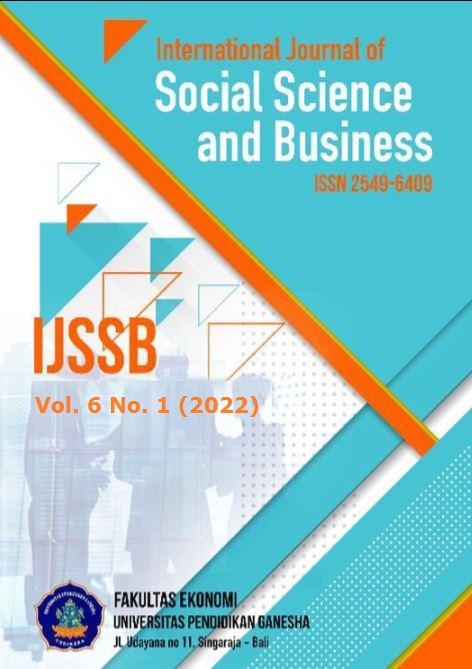Assessing the Role of Information and Communication Technology on Business Growth in Sumatera Island, Indonesia
DOI:
https://doi.org/10.23887/ijssb.v6i1.40511Keywords:
ICT, business growth, innovation, intermediaries, SumateraAbstract
Teknologi informasi dan komunikasi (TIK) telah menjadi bagian tak terpisahkan dari kehidupan sehari-hari, termasuk dalam bisnis. TIK adalah teknologi yang digunakan untuk menganalisis, menyimpan, dan menyebarkan informasi, serta mendorong operasi yang saling terkait dan efisien guna mendukung kinerja bisnis yang lebih baik. Penelitian ini bertujuan untuk menguji perbedaan pertumbuhan bisnis antara perusahaan yang menggunakan dan tidak menggunakan teknologi informasi dan komunikasi (TIK). Penelitian dilakukan di Pulau Sumatera, Indonesia. Sumatera dipilih karena meskipun merupakan penyumbang ekonomi terbesar kedua bagi Indonesia setelah Jawa, namun indeks perkembangan TIK-nya rendah dibandingkan dengan wilayah lain. Studi ini memanfaatkan gelombang data publik terbaru dari Survei Perusahaan Bank Dunia untuk Indonesia. Enterprise Survey mensurvei 194 perusahaan di dua provinsi: Provinsi Sumatera Utara dan Provinsi Lampung. Chi-square dan Mann-Whitney U Test digunakan untuk menganalisis data. Berdasarkan hasil temuan, TIK lebih umum digunakan di perusahaan besar, sementara lebih jarang digunakan di UKM. Pertumbuhan bisnis perusahaan yang menggunakan dan tidak menggunakan media email berbeda secara signifikan, sedangkan perbedaan dalam pemanfaatan situs web tidak signifikan. Perbedaan kecil dalam penggunaan situs web dapat dikaitkan dengan semakin populernya perantara dalam platform e-niaga yang inovatif.
References
Agahari, W. (2018). Digital innovation in Indonesia: inequalities between the east and the west. The Conversation.
AlBar, A. M., & Hoque, M. R. (2019). Factors affecting the adoption of information and communication technology in small and medium enterprises: a perspective from rural Saudi Arabia. Information Technology for Development, 25(4), 715–738. https://doi.org/10.1080/02681102.2017.1390437.
DeStefano, T., Kneller, R., & Timmis, J. (2018). Broadband infrastructure, ICT use and firm performance: Evidence for UK firms. Journal of Economic Behavior and Organization, 155, 110–139. https://doi.org/10.1016/j.jebo.2018.08.020.
Dewi, D. M., & Wulandari, I. Y. (2018). The Impact of Information and Communication Technology (ICT) on Regional Economy in Indonesia 2012-2018. Asian Journal of Business Environment, 11(3), 21–32. https://www.koreascience.or.kr/article/JAKO202118748168313.page.
Gërguri-Rashiti, S., Ramadani, V., Abazi-Alili, H., Dana, L. P., & Ratten, V. (2017). ICT, Innovation and Firm Performance: The Transition Economies Context. Thunderbird International Business Review, 59(1), 93–102. https://doi.org/10.1002/tie.21772.
Gunawan, R., Aulia, S., Supeno, H., Wijanarko, A., Uwiringiyimana, J. P., & Mahayana, D. (2020). Adiksi Media Sosial dan Gadget bagi Pengguna Internet di Indonesia. Techno-Socio Ekonomika, 14(1), 1–14. https://doi.org/10.32897/techno.2021.14.1.544.
Gurău, C., Dana, L.-P., & Lasch, F. (2012). Academic entrepreneurship in UK biotechnology firms: Alternative models and the associated performance. Journal of Enterprising Communities: People and Places in the Global Economy, 6(2), 154–168. https://doi.org/10.1108/17506201211228958.
Hadjimanolis, A. (2000). A resource-based view of innovativeness in small firms. Technology Analysis & Strategic Management, 12(2), 263–281. https://doi.org/10.1080/713698465.
Heintze, T., & Bretschneider, S. (2000). Information technology and restructuring in public organizations: Does adoption of information technology affect organizational structures, communications, and decision making? Journal of Public Administration Research and Theory, 10(4), 801–830. https://doi.org/10.1093/oxfordjournals.jpart.a024292.
Hewitt, P. (2006). Electronic mail and internal communication: A three-factor model. Corporate Communications, 11(1), 78–92. https://doi.org/10.1108/13563280610643570.
Ivus, O., & Boland, M. (2015). The employment and wage impact of broadband deployment in Canada. Canadian Journal of Economics/Revue Canadienne d’économique, 48(5), 1803–1830. https://doi.org/10.1111/caje.12180.
Munikrishnan, U. T., Imm, N. S., Ann, H. J., & Yusof, R. N. R. (2019). Disintermediation threat: Do small medium traditional travel agencies in Malaysia embrace ICT adequately? Pertanika Journal of Social Sciences and Humanities, 27(1), 707–728. http://psasir.upm.edu.my/id/eprint/67813/1/47 JSSH-2617-2017.pdf.
Neirotti, P., Raguseo, E., & Paolucci, E. (2018). How SMEs develop ICT-based capabilities in response to their environment: Past evidence and implications for the uptake of the new ICT paradigm. Journal of Enterprise Information Management, 31(1), 10–37. https://doi.org/10.1108/JEIM-09-2016-0158.
Ntwoku, H., Negash, S., & Meso, P. (2017). ICT adoption in Cameroon SME: application of Bass diffusion model. Information Technology for Development, 23(2), 296–317. https://doi.org/10.1080/02681102.2017.1289884.
Pallant, J. (2011). SPSS Survival Manual. Open University Press.
Perales, D. P., Valero, F. A., & García, A. B. (2018). Industry 4.0: a classification scheme. In Closing the Gap Between Practice and Research in Industrial Engineering (pp. 343–350). Springer.
Pick, J. B., & Nishida, T. (2015). Digital divides in the world and its regions: A spatial and multivariate analysis of technological utilization. Technological Forecasting and Social Change, 91, 1–17. https://doi.org/10.1016/j.techfore.2013.12.026.
Sfenrianto, S., Wijaya, T., & Wang, G. (2020). Assessing the buyer trust and satisfaction factors in the E-marketplace. Journal of Theoretical and Applied Electronic Commerce Research, 13(2), 43–57. 10.4067/S0718-18762018000200105.
Spulber, D. F. (2019). The economics of markets and platforms. Journal of Economics and Management Strategy, 28(1), 159–172. https://doi.org/10.1111/jems.12290.
Sunday, C. E., & Vera, C. C. E. (2018). Examining information and communication technology (ICT) adoption in SMEs: A dynamic capabilities approach. Journal of Enterprise Information Management, 31(2), 338–356. https://doi.org/10.1108/JEIM-12-2014-0125.
The World Bank. (2015). Enterprise Surveys Indonesia. Enterprise Surveys.
The World Bank. (2020). Performance / Annual employment growth % - TCdata360.
Zhang, P., Aikman, S. N., & Sun, H. (2008). Two Types of Attitudes in ICT Acceptance and Use. International Journal of Human Computer Interaction, 24(7), 628–648. https://doi.org/10.1080/10447310802335482.
Zuppo, C. M. (2012). Defining ICT in a Boundaryless World : The Development of a Working Hierarchy. International Journal of Managing Information Technology, 4(3), 13–22. https://doi.org/10.5121/ijmit.2012.4302.
Downloads
Published
How to Cite
Issue
Section
License
Copyright (c) 2022 International Journal of Social Science and Business

This work is licensed under a Creative Commons Attribution-ShareAlike 4.0 International License.











